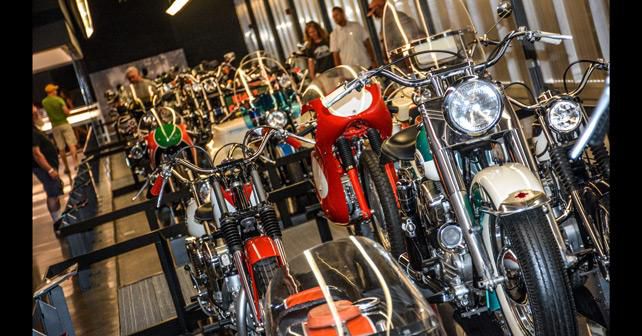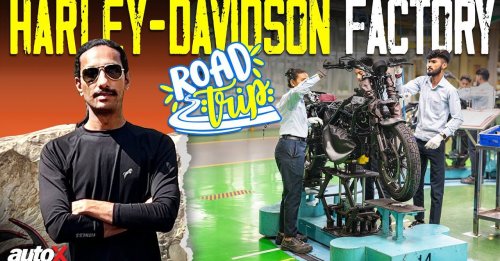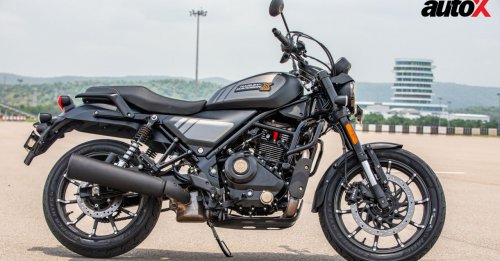The legendary American bike manufacturer is celebrating 60 years of the Sportster. So, we decided to celebrate with them by riding across the American Midwest and visiting the place where it all began.
I’ve wrestled with the concept of religion my whole life. I was raised in a strong Christian family, but I’ve always been an agnostic – which, amongst many other views and opinions, really bothered me most of my life. But all of that changed when I learnt how to ride a motorcycle. Don’t get me wrong, I still haven’t the faintest idea of what to believe in this world. But I found a way of distracting myself from the absurdity of the rollercoaster of human emotion. And it’s not just me, ask any motorcycle enthusiast and they will tell you the same thing – it’s the feeling of complete freedom. Not of the physical world, but freedom of the mind and freedom of the soul. Free of doubt, free of worry, and free of thought – absolute freedom!
This has always been the key underlying purpose of Harley-Davidson. “Fulfilling dreams of personal freedom,” is what the legendary bike manufacturer claims. The reason the Harley-Davidson brand is one of the strongest in the world today is because they’ve been selling this idea of freedom since 1903, and it’s worked. When William S. Harley and his best friend Arthur Davidson got together to work tirelessly in a 10 x 15 foot shed, I wonder if they ever imagined that their idea of freedom would change the world forever. Today, the Harley-Davidson Motor Company is the most iconic bike manufacturer in the world with factories all across the globe, a workforce of more than 6,000 people, and millions of loyal customers and fans. You will not meet a person today who doesn’t know what Harley-Davidson is, and what it stands for.
My first tryst with a Harley-Davidson motorcycle happened in the summer of 2005 when my college buddy and I rode two of his dad’s custom-built Sportsters from New York all the way to Los Angeles. I will never forget that experience, because it was my first long distance ride – and what an epic ride it was. Maybe that’s why the Sportsters have always been my favourite – because I have a personal connection with them. I like fast and nimble bikes, and the Sportster is all that and more. Five years later, in 2010, I found myself back in India and working as an automotive journalist – and it just so happened that Harley-Davidson set-up shop in India at the same time. Over the years, the XR1200, the Forty-Eight, and just this year the Roadster, became my favourite motorcycles from Harley Davidson.
Fast forward to 2017, and here we are in the 60th year of the Sportster line. The Sportster has been in continuous production for 60 years, and it was developed primarily for racing – hence the name. Another fun fact is that 2017 just so happened to be my ten-year college reunion, and I was heading back to good ol’ Minnesota for the summer. I had a few extra days to spare, and so I asked my friends at Harley-Davidson India if they would be kind enough to hook me up with a bike so that I could ride down to Milwaukee and visit the birthplace of the legendary American bike-maker.
After spending a wonderful few weeks with my family at their lake cabin in Cambridge, my cousin dropped me off to the St. Paul Harley-Davidson dealership – and sitting pretty, waiting for me, was a beautiful black Roadster. “The Sportster connection is still strong,” I said to myself.
I put on my riding gear, saddled up, started up that beautiful V-Twin engine, and my ears were met with a familiar sound – the sound of freedom. It was late in the afternoon, and I had a long ride ahead of me. I got out of the Twin Cities as fast as I could, and before I knew it I was in Wisconsin – on the open road, with nothing but green fields and a bright blue sky in sight. The scenery was breath taking, and, with that familiar feeling of riding in the wind without a care in the world, it was a holistic experience.
I reached Milwaukee just after sunset, checked into my hotel room, ate a nice steak dinner, sampled the local beer, and then got a good night’s rest. The next morning I took my time and rode around the city. I was now in the birthplace of Harley-Davidson, and it was clearly evident. Everywhere I went there were scores of Harley-Davidson motorcycles. I finally decided to head to the Harley Davidson Museum, and, as my luck would have it, it happened to be a Thursday – and every Thursday in the summer is Bike Night. There must have been about 200 bikes, and everyone was in a celebratory mood.
The building that houses the museum is a sight to see in itself. The Harley-Davidson Museum was opened to the public in 2008, and there are actually three buildings spread across a 20-acre complex. They charge $20 (Rs.1,300) for general admission, and you could probably spend about two hours to see everything on display. The museum itself is spread across two floors and features everything and anything to do with Harley-Davidson history. You can learn the chronological history of the company, and there is every major historical bike – including the oldest known Harley-Davidson in existence. There are a total of 450 motorcycles on display, as well as a couple hundred thousand artefacts spanning the glorious 114 years of the company. My favourite exhibit was the 1990 Fat Boy that was ridden by Arnold Schwarzenegger in the movie Terminator 2: Judgement Day. Another interesting exhibit was the 2004 Harley-Davidson Night Train motorcycle that was swept away in the devastating tsunami in Japan and ended up 4,000 miles away on the western shore of Canada. The Japanese owner decided to donate the bike – which was still intact but severely rusted and damaged – to the museum.
There were, of course, other interesting exhibits and sections in the museum, such as the Engine Room, the Tank Gallery and the Clubs and Competition section. There are so many things to see that, even if you aren’t a motorcycle enthusiast, you’re bound to enjoy your visit. And if all the walking around gets you hungry, there’s also a restaurant on the premises with some pretty awesome food – such as the delicious hamburger I sampled. I hung around for Bike Night and spoke to a few people about the city, and about their own personal experiences as Harley-Davidson owners. I met people from all walks of life, and of all ages. I met doctors, war veterans, teachers, retired couples, businessmen, and there was even a pretty young lady who worked as a librarian. All of them came from different backgrounds, with different life stories, but they all share one thing in common – they all love the feeling of freedom you get by owning a Harley-Davidson. One gentleman explained it best – saying, “Birds have wings, but we have Harleys.”
One thing that I’ve noticed about Harley-Owners is that they are loyal and friendly, and it’s not just because I was in the Midwest where almost everyone is nice. This fact holds true the world over, because the Harley-Davidson brotherhood, and the many hundreds of Harley Owners Groups, have a great sense of camaraderie and community. Owning a Harley-Davidson and interacting with fellow owners is a way of life, and the owners look at it as one big happy family. Harley-Davidson, as a brand, holds the kind of power that it has because the vast majority of their customers are very happy and proud to be owners. It’s hard to explain, but sitting and talking to them that evening I sort of experienced what they felt – and it was charming and admirable. I felt like I belonged there, even though it was my first visit to the city and I didn’t know a single person’s name.
I got back on the Roadster, and revved her hard as I rode out – as a way of saying goodbye and showing my gratitude. The next day, I was scheduled for a private tour of the Pilgrim Road Powertrain Operations facility in Menomonee Falls. This facility is where the heart and soul, and styling centrepiece, of every Harley-Davidson is created. It’s home to the Sportster engine, and it’s also where the Milwaukee-Eight and Twin Cam engines are assembled. I was met by a fun and energetic tour guide, who knew more about engines than I probably did.
The Pilgrim Road Powertrain Operations has over 1,000 employees who are passionate and dedicated, and they produce engines and transmissions for the final assembly plants located elsewhere in the country. Although built in 1979, the Pilgrim Road facility was acquired by Harley-Davidson in 1996. It covers 912,000 square feet spread across 63 acres. There are over 150 parts in a Harley-Davidson engine, and, at this facility, operations include steel and aluminium machining, powder coating, heat-treating, assembly, and more. I was shown the different processes of assembly for the engine and its parts. It’s not the biggest facility I’ve visited, but it certainly seemed highly efficient.
After a quick tour, I got back onto the open road and headed back to Minnesota. This time I was riding up to Duluth to visit my Alma mater – I hadn’t been back in over ten years. As I rode on some beautiful backcountry roads into the sunset, throttle twisted all the way, eyes fixed on the horizon, I felt that feeling again. It was calm, soothing, and almost poetic. It’s the feeling that people search for their entire lives, but can seldom find. It’s that blissful moment of feeling completely free. Riding a motorcycle is a way for us to find ourselves, even when we don’t know where we are or where we’re going – our own version of escapism and salvation, and this is what Harley-Davidson has been encouraging and sponsoring for over a century. Harley-Davidson doesn’t just sell motorcycles, they sell a way of life. They sell people their own personal freedom.


















































Write your Comment